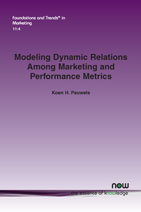Modeling Dynamic Relations Among Marketing and Performance Metrics
By Koen H. Pauwels, Northeastern University, USA, koen.h.pauwels@gmail.com
Abstract
Marketing and performance data often include measures repeated over time. Time-series models are uniquely suited to capture the time dependence of both a criterion variable and predictor variables, and how they relate to each other over time. The objective of this monograph is to give you a foundation in these models and to enable you to apply them to your own research domain of interest. To this end, we will discuss both the underlying perspectives and differences between alternative models, and the practical issues with testing, model choice, model estimation and interpretation common in empirical research. This combination of marketing phenomena and modeling philosophy sets this work apart from previous treatments on the broader topic of econometics and time series analysis in marketing.
Modeling Dynamic Relations Among Marketing and Performance Metrics
Marketing and performance data often include measures repeated over time. Time-series models are uniquely suited to capture the time dependence of both a criterion variable and predictor variables, and how they relate to each other over time. The objective of this monograph is to give you a foundation in these models and to enable you to apply them to your own research domain of interest. To this end, the author discusses both the underlying perspectives and differences between alternative models, and the practical issues with testing, model choice, model estimation and interpretation common in empirical research. This combination of marketing phenomena and modeling philosophy sets this work apart from previous treatments on the broader topic of econometics and time series analysis in marketing. Time series models on marketing and performance metrics come in different forms, and we distinguish between ‘traditional’ time series models and the ‘modern’ time series models.
Modeling Dynamic Relations Among Marketing and Performance Metrics first details the analysis steps, interpretation and marketing insights from traditional time series models. Starting with the univariate treatment of each separate marketing time series in evolution/stationarity tests and ARIMA models. Next, the author considers the over-time relation of multivariate time series in transfer functions and intervention analysis. The monograph then turns to multi-equation models, which are the core workhorses of modern dynamic econometric and time series models of the dynamic relations among marketing and performance metrics. The concluding section discusses policy analysis based on modern time series models and connect them to other time series developments.
